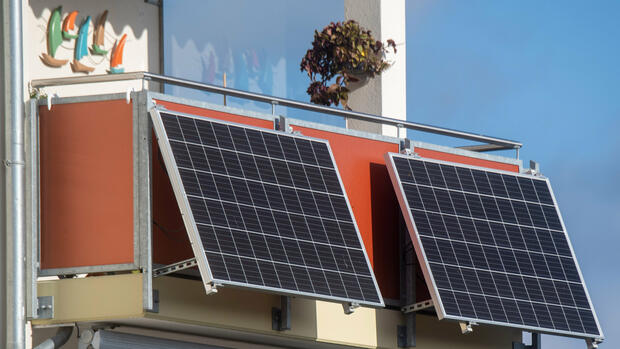Many Germans want to generate energy with solar cells on the balcony – and thus save money.
(Photo: dpa)
Bonn/Berlin More and more citizens in Germany have installed their own small solar systems on their houses or apartments. The number of so-called balcony power plants has doubled since the beginning of the year, as can be seen from the Federal Network Agency’s market master data register. The register currently shows around 230,000 ready-to-plug-in generation systems – that’s the official name. For almost 137,000 of them – more than half – the commissioning date is in the current year.
The number of systems is likely to be even higher. According to the Federal Network Agency, there are around 30,000 other systems in the register with an output of less than one kilowatt, of which it is not clear whether they are also balcony power plants. In addition, there is an unknown number of systems that are not registered and not registered with the electricity provider – contrary to legal requirements.
The small and comparatively cheap balcony power plants have gained in popularity since last year – also because of the sharp rise in electricity prices. They usually consist of one or two solar modules and an inverter. This converts the solar power into household power, which can be fed directly into the socket. Household appliances can then be operated with the electricity. In return, less electricity is drawn from the public grid. According to the consumer advice center, whether such a system is worthwhile depends, among other things, on the purchase price and electricity price, but also on whether the module gets as much sun as possible for as long as possible.
>> Also read: Balcony power plants with pitfalls: How to eliminate the risk of electric shock
Despite the strong growth, the power plants do not yet play a major role in power generation. Even if you add the 30,000 systems with an unclear status, according to the Federal Network Agency they only have a total output of 170 megawatts and are likely to generate a maximum of 170 gigawatt hours per year. That is 0.3 per mil of German electricity consumption.
However, the federal government wants to further facilitate the installation of the systems and thus give the topic a further boost. According to a draft by the Ministry of Justice, the installation should be made easier for tenants and apartment owners. They should have a legal right to have the devices installed. This would eliminate the need to justify an application for installation to the landlord or the owners’ meeting.
Reluctance in the south of all places
The Ministry of Economics is also aiming for an increase in the power limit from 600 to 800 watts and simplified reporting requirements for plug-in solar devices. Until now, these had to be entered in the Federal Network Agency’s market master data register and reported to the network operator. This double notification should be omitted.
The general manager of the German Solar Industry Association (BSW), Carsten Körnig, welcomed the simplifications, but at the same time spoke of the corresponding need for action for the larger roof and other photovoltaic systems.
The BSW expects that the share that plug-in solar devices provide to cover the electricity demand in Germany will remain comparatively low for the foreseeable future. But the devices enabled many people to actively participate in the energy transition “and thus also increase the acceptance of renewable energies,” emphasizes Körnig. The advantages of the systems lie in the technical simplicity as well as in the low-cost acquisition as an entry into their own solar power generation for tenants and apartment owners. The Federal Ministry of Economics comes to similar assessments in its photovoltaic strategy.
Incidentally, the systems registered in the market master data register are distributed quite unequally within Germany. They are particularly popular in northern Germany of all places. In Mecklenburg-Western Pomerania there are five plants per 1000 inhabitants, in Schleswig-Holstein it is 4.2 and in Lower Saxony 3.8. The south with Bavaria and Baden-Württemberg, on the other hand, is below the German average of 2.7. The city states bring up the rear with values between 1 and 1.5. In view of their development structure, however, they also have poorer starting conditions for the plants.
More: The traffic light wants to make it easier to use the mini solar systems
